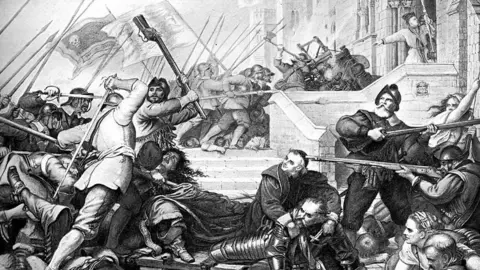Civil war massacre 'cover-up' exposed by historian
 Getty Images
Getty ImagesA "frenzied" massacre, which may have included women and children, was the subject of a cover-up, a historian has claimed.
About 160 died when Parliamentary troops stormed the Royalist stronghold of Shelford, Nottinghamshire, in 1645.
Dr David Appleby believes the presence of "European Catholics" among the dead and unease over the bloodshed led to the battle later being hushed up.
He said: "Shelford was covered up by both sides."
"The Parliamentarians wanted to forget the savagery, the Royalists, the use of unpopular foreign troops," he added.
Dr Appleby, from the University of Nottingham's history department, said he was prompted to research Shelford as it did not appear in histories of the war, but he noticed it mentioned in contemporary documents asking for financial aid.
Shelford was a moated manor between Nottingham and the Royalist fortress of Newark.
The war began in 1642 between supporters of King Charles I's absolute rule and those who believed Parliament should run England.
 Dr David Appleby
Dr David ApplebyIn the aftermath of Charles's decisive defeat at Naseby in June 1645, Parliamentary forces looked to mop up areas of resistance.
"Some of Charles' battered army were billeted at Shelford, namely the Queen's Regiment who were mainly European Catholics with a very bad reputation among fellow Royalists, as well as the xenophobic and anti-Catholic parliamentarian press," said Dr Appleby.

What was the English Civil War?
- The conflict was a series of civil wars which began in 1642 and ended in 1651. Although usually called the English Civil War, it was a much wider conflict also involving Scotland, Ireland and Wales
- The first and second wars involved King Charles I, while the third saw fighting between supporters of King Charles II and supporters of Parliament
- The war ended in defeat for the Royalists on 3 September 1651, after which the younger Charles fled the country.

Dr Appleby said the attackers were "in a state of frenzy".
"Records of the Royalist casualties are vague, but it's estimated [the defending commander] died with the bulk of his garrison," he said.
"Their bodies were perhaps mutilated after death and buried together in hastily-dug pits somewhere near the battle site.
"There is also a claim in a petition... that several women and children in the garrison had also been murdered."
He believed while some women were soldiers' wives, others joined the Army on the road.
"They worked as nurses, cooks, companions, and it has to be said that prostitution was very common," he said.
Despite the blood-letting, the battle quickly disappeared from the written record.
Dr Appleby said: "It is... perhaps a reflection of both sides' shame and embarrassment at the bloodshed and viciousness of the supposedly 'civil' Civil Wars."

Follow BBC East Midlands on Facebook, Twitter, or Instagram. Send your story ideas to [email protected].
